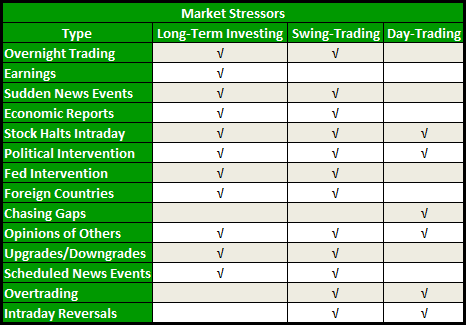I want to continue on the article I published last week on Eliminating “Hope” from your trading. One way to do that is by identifying the key market stressors in your trading style and how they affect you personally in how you approach the market. Because Hope, as great and wonderful that word sounds, is detrimental to your trading, because Hope has a personality complex with Frustration. When Hope meets reality, you end up with a Dr.Jekyll and Mr. Hyde scenario, and for trading such a mindset leads to destruction of your capital.
I’ve put together a chart below that shows three different trading styles (can’t include them all), and the stressors that are associated with each of them. I, for one, am a horrible long-term investor, and much of that has to do with my patience level, of waiting over a long period of time for a stock to do what it should do. Also, I have a hard time holding stocks through earnings, and “believing in a company” with out having access to the company outside of their published documents that they provide to everyone. As a result I am a hybrid of a day-trader and swing-trader which I will discuss more below:

Now its plain obvious that day-trading, based on the chart above, has the fewest amounts of market stressors (I’m sure I didn’t include them all) but with day-trading too, the profits are typically smaller, and the commissions are more. While Long-term Investing has more market stressors, but far greater profits as well, and fewer decisions on a day-to-day basis that must be made.
Swing-Trading you’ll see doesn’t have anything unique in and of itself, but tends to incorporate trading philosophies from both day-traders and swing-traders, and thus has the most stressors.
I’ve always considered myself to be a swing-trader, but over the years, I have found my time frame in which I trade in, becoming less and less. Whereas five years ago, you’d never see me day-trading, but today, it is not uncommon for me to make four or five day-trades in a single day. But I haven’t abandoned swing-trading either, but I tend to do the swing-trading when the market stressors are more managable.
For instance, the overnight trading and large gaps up and down tend to create higher levels of stress for me in volatile markets, which means then I have to condense my time frame and looks for quicker gains. So I have to be cognizant of the periods of elevated stress in my trading and make the necessary adjustments to the style that I embrace at that given time.
As should you. If you dread the weekly Jobless Claims report, and find yourself consistently making bad decisions often times in response to economic news, you may want to shorten your time frame for trading. And vice-versa, if you are overtrading the markets as a day-trader, and constantly chasing gaps, then you need to adjust, expand your time frame, and make the move towards swing-trading.
So, all in all, you have to know what trading style is going to suit you the best – the table above does a good job helping to narrow that down some. But failure to recognize the stresses that you struggle in dealing with, and making the appropriate changes as well, will result in your ultimate demise as a trader.

Welcome to Swing Trading the Stock Market Podcast!
I want you to become a better trader, and you know what? You absolutely can!
Commit these three rules to memory and to your trading:
#1: Manage the RISK ALWAYS!
#2: Keep the Losses Small
#3: Do #1 & #2 and the profits will take care of themselves.
That’s right, successful swing-trading is about managing the risk, and with Swing Trading the Stock Market podcast, I encourage you to email me (ryan@shareplanner.com) your questions, and there’s a good chance I’ll make a future podcast out of your stock market related question.
How should one go from their regular 9-5 job into full-time trading? As a swing trader, we don't have to necessarily be full-time, and instead we can combine our trading into a lifestyle that allows us to maximize our time and earning ability.
Be sure to check out my Swing-Trading offering through SharePlanner that goes hand-in-hand with my podcast, offering all of the research, charts and technical analysis on the stock market and individual stocks, not to mention my personal watch-lists, reviews and regular updates on the most popular stocks, including the all-important big tech stocks. Check it out now at: https://www.shareplanner.com/premium-plans
📈 START SWING-TRADING WITH ME! 📈
Click here to subscribe: https://shareplanner.com/tradingblock
— — — — — — — — —
💻 STOCK MARKET TRAINING COURSES 💻
Click here for all of my training courses: https://www.shareplanner.com/trading-academy
– The A-Z of the Self-Made Trader –https://www.shareplanner.com/the-a-z-of-the-self-made-trader
– The Winning Watch-List — https://www.shareplanner.com/winning-watchlist
– Patterns to Profits — https://www.shareplanner.com/patterns-to-profits
– Get 1-on-1 Coaching — https://www.shareplanner.com/coaching
— — — — — — — — —
❤️ SUBSCRIBE TO MY YOUTUBE CHANNEL 📺
Click here to subscribe: https://www.youtube.com/shareplanner?sub_confirmation=1
🎧 LISTEN TO MY PODCAST 🎵
Click here to listen to my podcast: https://open.spotify.com/show/5Nn7MhTB9HJSyQ0C6bMKXI
— — — — — — — — —
💰 FREE RESOURCES 💰
— — — — — — — — —
🛠 TOOLS OF THE TRADE 🛠
Software I use (TC2000): https://bit.ly/2HBdnBm
— — — — — — — — —
📱 FOLLOW SHAREPLANNER ON SOCIAL MEDIA 📱
*Disclaimer: Ryan Mallory is not a financial adviser and this podcast is for entertainment purposes only. Consult your financial adviser before making any decisions.




